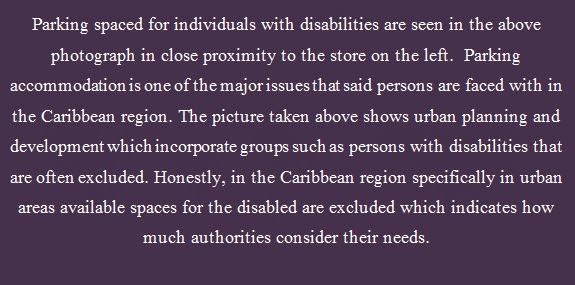The government of Trinidad and Tobago has outlined numerous measures to be employed to facilitate individuals with disabilities. The issue is that they are either not employed or not employed and enforced effectively to sufficiently accommodate such individuals. Below are measures that can be implemented in the short term to main spaces in urban areas.
1. The most important issue would be to amend any
existing document as to ensure that all needs are satisfied and no loop
holes are available for others to exploit. This goes for all urban planning and
policy documents as well as any act concerning individuals with disabilities.
In an article published in April on the UWI Today online publications titled,
Taking the Charge NODES (The UWI Network and Outreach for Disability Education
and Sensitisation) host landmark disability conference, highlighted the ‘leeway’
that the Equal Opportunities Act gave employers. It states that in its present
form it allows employers to discriminate against individuals with disabilities
in regards to payment. In another article referenced in an earlier post Sharda
Ramlakhan spoke of the ways individuals with disabilities are still
disadvantaged in terms of simple accessibility issues in main areas of Trinidad
even though plans are established. These examples highlight the need for
review, amendment and stringent enforcement. (eg review and proper enforcement
of building codes)
2. Sharda Ramlakhan in her interview also mentioned the
need for consultations with individuals with disabilities and
organisations that represent said individuals. This is important as such
individuals have first had experience and knowledge and would give advice on
effective measures. It will also allow them to express their view and understand that their opinion is valued. The majority of planners and individuals in power employ a
top-down approach in which failure to eradicate the problem/s occur. In these
instances, the voices of the persons who are marginalised are absent from any
planning, management or implementation.
 |
| (click to enlarge) Source: (Ali, 2013) |
- Ramps with railings at the entrances of the building should be established in order to facilitate person with disabilities. It should be mandatory that ramps and railings at the entrances of all buildings are implemented.
 |
| Image 1 shows Independence Square in PoS. A ramp and railing is employed so that individuals with disabilities can access the buildings easier. Source: P. D'andra Nanda (click to enlarge) |
-Automatic doors should also be included to accommodate the disabled community as it would benefit the persons in wheelchairs and the visually impaired. In cases where these doors cannot be implemented long handled doors should be designed and set in place so that no matter the type of disabilities, doors can be opened or closed.
 |
| Image 2 showing an emergency exit door. Source: Category: Home Page (click to enlarge) |
-Toilet facilities should be able to accommodate the disabled. Automatic sensors, specialized toilet and large enough changing rooms should be established especially for persons who are dependent on wheelchairs.
- Pertaining to evacuation procedures or emergency exists in building; authorities should consider how individuals with disabilities would safely exit buildings. Alarms and various sound systems should be implemented to facilitate these individuals to exit the buildings. In cases where electricity is switched off mechanical lifts should be utilized to accommodate persons with disabilities or inclined ramps alongside the emergency staircase.
Streets
-Acoustic devices and tactile squares should be placed where traffic lights are in urban areas which would notify the persons with hearing or visual impairments on when it is appropriate to cross or move. Tactile squares are sensory paths that help notify persons with hearing or visual impairments at crossing zones. Implementing these would help improve the lifestyle of these persons.
-Establishing pavements with gentle sloping kerb ramps would facilitate the easy access onto pavements to persons dependent on wheelchairs. Ensuring that damaged pavements are repaired quickly would be beneficial to these groups. Widening pavements should be done throughout the city area in order to facilitate these groups. Avoiding the implementation of step on pathways should be highly considered by planners.
 |
| Image 3 showing a sidewalk. Location is MD-98 210 Fort Meade Rd, Laurel MD 20707, United States of America. (Cross Streets) Source: Jonathan E. Ramnarine (click to enlarge) |
 |
| (click to enlarge) |
-Parking facilitates specifically created for individual with disabilities should implemented in the public spaces. These parking areas should be located in close proximity to main areas needed to be accessed by said individuals. Bus stops should be adjusted to accommodate person with disabilities and should be implemented in a different area from the abled bodied individuals.
 |
| Image 4 showing a parking lot with accommodations for individuals with disabilities. Location: (Home Depot) Laurel, Maryland, United States of America Source: Jonathan E. Ramnarine (click to enlarge) |
 |
| (click to enlarge) |
Recreational spaces
-These spaces should be user friendly for person with individuals as they too would like the opportunity to explore leisure and to relax. Accessibility to these parks should be properly established with wide enough pathways for person with wheelchairs. Signs should be implemented to notify the public that the parks is utilize by person with disabilities so caution must be practiced.
References
Ali, S. (2013, November 17). Sharda Ramlakhan: Disabled
have rights too. Guardian. Retrieved from http://m.guardian.co.tt/
Category: Home Page. (n.d.). Retrieved March 10, 2015, from http://originalhomeideas.com/category/uncategorized/page/71/
Leading the Charge. (2015, April). UWI
Today. Retrieved from http://sta.uwi.edu/uwiToday/article14.asp
No comments:
Post a Comment